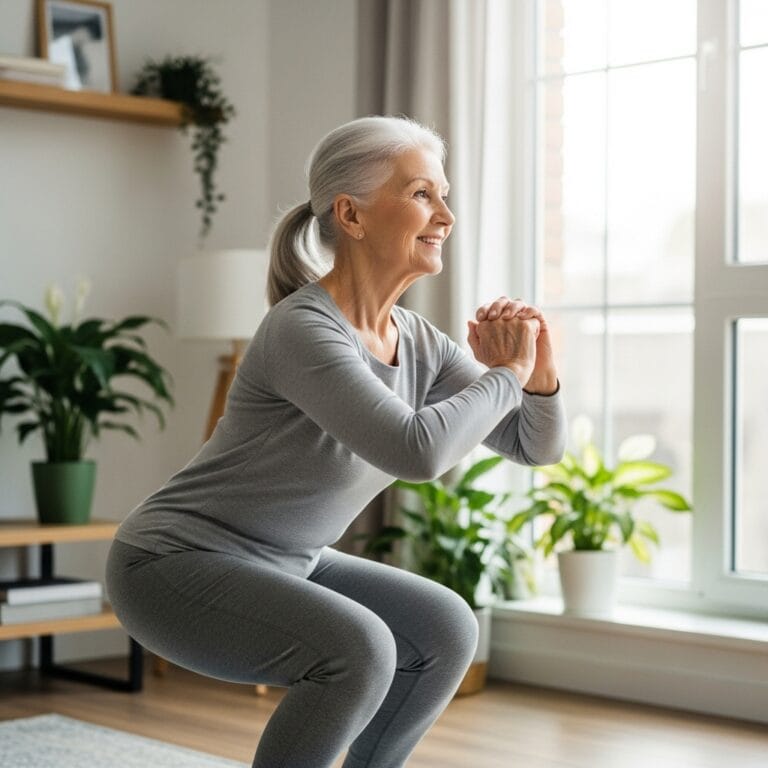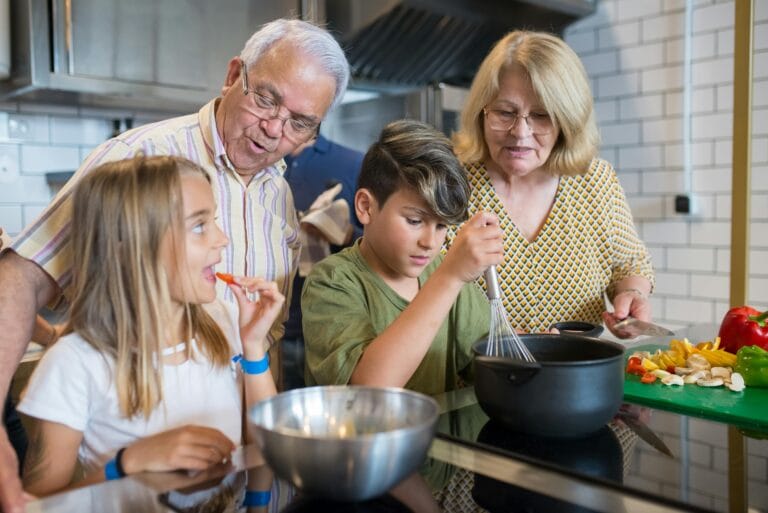FREE SHIPPING OVER $50
The “Age Test” Experts Use: If You Struggle With These 5 Movements, You’re Aging Faster Than You Think
Have you ever stopped to consider not just your chronological age (the number of years you’ve been alive), but your biological age? This is the true measure of how well your body is actually functioning, independent of your birthdate. And here’s a sobering thought: for many of us, our biological age might be significantly higher than our calendar age, meaning our bodies are aging faster than we realize.
It’s easy to dismiss aches, stiffness, or a general decline in physical ability as simply “getting older.” But what if these seemingly minor struggles in everyday movements are actually flashing red lights, signaling that your body’s systems are deteriorating at an accelerated rate? Leading longevity experts and functional fitness gurus understand that your ability to perform basic movements is a powerful predictor of your future health, mobility, and independence.
Biological Age vs. Chronological Age: Why It Matters

Your chronological age is fixed. Your biological age, however, is dynamic. It reflects the health and efficiency of your cells, organs, and systems. Factors like diet, exercise, stress, sleep, genetics, and environmental toxins all play a huge role in determining how fast your body actually ages.
Functional movement is a key indicator of biological age because it reveals:
- Muscle Strength and Power: Are your muscles strong enough to support you?
- Balance and Stability: Can your body maintain equilibrium and prevent falls?
- Flexibility and Mobility: Can your joints move through their full range of motion?
- Coordination and Proprioception: Do your brain and body communicate effectively?
The “Age Test”: 5 Foundational Movements to Master
Ready to take the test? These five movements are simple to understand but challenge multiple aspects of your physical function. Perform them safely, ideally near a wall or chair for support if you feel unsteady. Don’t worry if you can’t ace them all right away – the point is to identify areas for improvement.
1. The Full Squat (Deep Squat)
This isn’t a gym squat with weights. This is your ability to squat all the way down, buttocks nearly touching your heels, with your feet flat on the floor, and hold it comfortably.
- The Test: Stand with feet shoulder-width apart, toes slightly out. Keeping your chest up and back straight, slowly lower your hips as if sitting into a very low chair. Go as deep as possible while keeping your heels on the ground. Can you hold this position for 10-30 seconds? Can you stand back up smoothly?
- Why it matters: A full squat requires excellent ankle mobility, hip mobility, core strength, and lower body strength. Losing this fundamental human movement capacity is a huge sign of accelerated aging in your joints and muscles. Our ancestors could squat effortlessly; it’s a natural resting position.
- Aging Sign: If your heels lift off the ground, your back rounds excessively, or you can’t get low without falling backward, your ankles, hips, and core may be prematurely stiffening or weakening.
2. The Single-Leg Balance (Stork Stand)
This tests your static balance and core stability.
- The Test: Stand tall, lift one foot a few inches off the ground, and try to balance without holding onto anything. Can you hold this for 30 seconds with each leg?
- Why it matters: Good balance is paramount for fall prevention, especially as we age. It relies on strong ankles, core muscles, and effective communication between your brain and body (proprioception).
- Aging Sign: Struggling to hold for even 10-15 seconds, wobbling excessively, or needing to put your foot down frequently indicates a significant decline in balance and stability, increasing your fall risk.
3. The Standing Reach Test (Shoulder Mobility)
This assesses your shoulder mobility, crucial for everyday tasks like reaching for high shelves or dressing yourself.
- The Test: Stand straight with one arm fully extended overhead, palm facing forward. Try to bring your arm directly alongside your ear or slightly behind it without arching your back or shrugging your shoulder up. Repeat with the other arm.
- Why it matters: Good shoulder mobility is essential for functional independence. Stiffness here can lead to pain, limit arm movements, and affect posture.
- Aging Sign: If your arm can’t get anywhere near your ear, or you have to heavily arch your back to compensate, your shoulder joint and surrounding tissues may be tight or weak, signaling limited upper body function.
4. The Sit-and-Rise Test (SRT)
This is a powerful predictor of longevity and functional aging, involving strength, flexibility, and balance.
- The Test: From a standing position, lower yourself to a sitting position on the floor, cross-legged, without using your hands, knees, or arms for support. Once seated, stand back up from the cross-legged position, again without using your hands, knees, or arms.
- Scoring (simplified):
- Start with 10 points.
- Subtract 1 point for each time you use a hand to support yourself on the way down or up.
- Subtract 1 point for each time you use a knee, forearm, or side of your leg.
- Subtract 0.5 points for any loss of balance or wobble.
- Why it matters: A high score (8-10 points) indicates excellent strength, flexibility, balance, and body control. Studies have linked higher scores to increased longevity and lower mortality rates.
- Aging Sign: A score of 7 or below suggests significant limitations in functional strength and mobility that correlate with accelerated biological aging.
5. The Dynamic Lunge (Controlled Lunge)
This assesses lower body strength, balance, and hip flexibility in a dynamic movement pattern.
- The Test: Stand tall, then take a large step forward with one leg, lowering your hips until both knees are bent at approximately a 90-degree angle. Your front knee should be over your ankle, and your back knee should hover just above the ground. Push off your front foot to return to the starting position.
- Why it matters: Lunges mimic walking, running, and climbing stairs. Your ability to control this movement indicates strength in your quads, glutes, and hamstrings, along with balance and hip stability.
- Aging Sign: Difficulty stabilizing, falling off balance, or pain in the knees or hips during the movement suggests muscular weakness or joint stiffness that can impact your ability to move efficiently and safely.
Your Results: What Does This Mean for Your Biological Age?
If you struggled with several of these movements, it’s a clear signal that your body’s functional age might be older than your chronological age. But here’s the crucial part: this is not a life sentence. This is an opportunity for intervention!
Think of these movements as diagnostic tools. They pinpoint exactly where your body might be losing its youthful vitality. The good news is, these are all skills that can be improved, no matter your current age or fitness level.
Reversing the Clock: How to Improve Your Functional Age
The path to a younger biological age and enhanced longevity lies in consistently challenging your body in ways that restore and maintain these foundational movements.
- Prioritize Strength Training:
- Focus on Compound Movements: Squats, lunges, deadlifts (or deadlift variations), presses, and rows. These work multiple muscle groups and mimic natural movements.
- Use Progressive Overload: Gradually increase the weight, reps, or sets to continually challenge your muscles.
- Incorporate Unilateral Work: Single-leg exercises like lunges and single-leg Romanian deadlifts directly improve balance and fix imbalances.
- Improve Your Mobility and Flexibility:
- Daily Stretching: Focus on key areas like hips (hip flexors, glutes), ankles, and shoulders.
- Yoga or Pilates: These practices specifically target flexibility, core strength, and body awareness.
- Foam Rolling: Use a foam roller to release tight muscles and improve tissue quality.
- Boost Your Balance:
- Stand on One Leg: Practice simply standing on one leg while brushing your teeth or waiting in line.
- Walk on Uneven Surfaces: Challenge your balance by walking on grass or trails.
- Mindful Movement: Pay attention to your body’s position in space during everyday activities.
- Stay Active Throughout the Day (NEAT):
- Reduce Sedentary Time: Get up and move every hour. Take short walks, do some stretches.
- Take the Stairs: Opt for stairs instead of elevators.
- Walk More: Aim for at least 8,000-10,000 steps daily.
- Prioritize Recovery and Nutrition:
- Quality Sleep: 7-9 hours of sleep nightly is crucial for muscle repair and overall cellular health.
- Nutrient-Dense Diet: Fuel your body with whole, unprocessed foods, ample protein, healthy fats, and plenty of fruits and vegetables to support cellular function and reduce inflammation.
- Stay Hydrated: Water is essential for joint lubrication and cellular processes.
Embrace the Journey to a Younger You
Struggling with these “age test” movements isn’t a sentence; it’s a wake-up call and a powerful motivator. By proactively working on your strength, mobility, and balance, you’re not just improving your ability to perform these specific exercises. You’re actively reducing your biological age, enhancing your quality of life, increasing your longevity, and setting yourself up for a future filled with vibrant health and functional independence.
Related Articles
- Lose Your Muffin Top in 7 Days (Over 50 Edition): The Simple Trick Elite Trainers Swear By
- Defy Your Age: 75-Year-Olds Reveal Their Everyday Habits for Peak Energy & a Brilliant Mind
- Age-Proof Your Balance: 20 Exercises to Stay Steady, Confident, and Fall-Free
- Don’t Let Age Steal Your Strength: How To Prevent Sarcopenia & Retain Muscle As You Age
- From Wheelchair to Walking: 7 Exercises That Saved My Joints at 60



